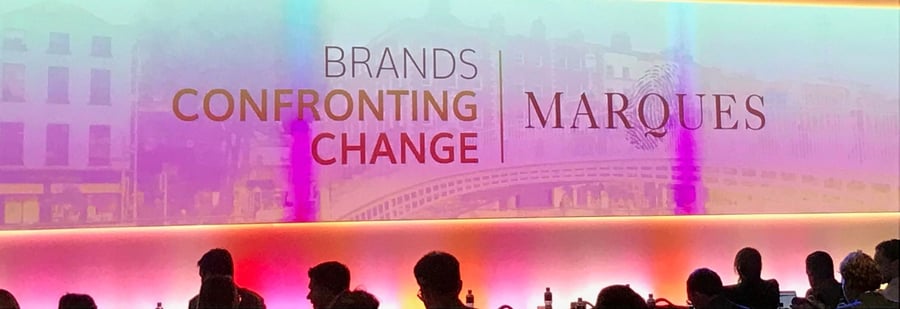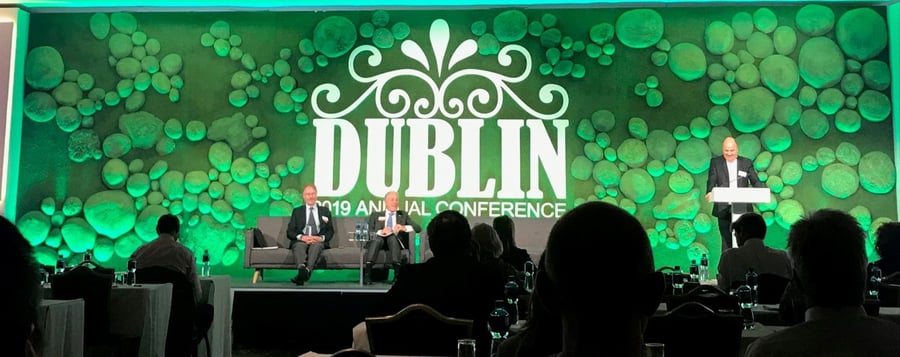October 22, 2019
Change was an overarching theme at the MARQUES conference, the main event of the European trademark sector this autumn. Kolster IP Lawyer was one of more than a thousand trademark professionals and brand owners who gathered in Dublin to discuss how brands can confront and overcome change and how change reflects on brand protection and legislation.
In the world of brands, change is a defining feature of our time. With the theme Brands Confronting Change, the 33rd MARQUES conference delved into the challenges faced by brand owners and IPR professionals in keeping up with the constantly changing market environment. Specific themes highlighted at the conference included differences between countries in consequences for trademark infringements and in practices related to damages.
“It is essential for brands to respond quickly to changes”
Presentations and panels at the conference raised discussion on the ability of brands to reform and respond to changes. It is important for brands to stay at the forefront of trends. Nobody can tell for certain what the future will hold in five or ten years. Despite this, brand owners must be able to respond to customers’ expectations and needs even before customers themselves recognise them.
Reform is particularly important for legacy brands, old and iconic trademarks that are established and long-standing in their line of business. Startup companies often adopt this way of thinking naturally from the get-go. Established brands, in turn, must engage in constant development work to ensure that their brand remains interesting and relevant.
It is clear that some brands are quicker and more capable of responding to changes in the environment compared with others. This directly affects the company’s success. At the conference, the legendary camera manufacturer Kodak was raised as an example of a brand that was at the time unable to quickly respond to the industry’s technological transformation and the needs of customers. The formerly successful camera brand was left out in the cold by the changes.

“The brand of today is a story that reflects also in its protection”
As the conference was held in Dublin, a natural example of a developing and reinventing brand was of course no other than Guinness. Guinness beer has been brewed in Dublin since 1759. The iconic brand has been able to reform itself and construct a fantastic story. The brand story is also reflected in the company’s harp emblem, which is known throughout the world as a symbol of Ireland.
Story is a word that aptly describes today’s brands. Because they are tied to a story, trademarks are no longer simply neutral indicators of commercial origin, except from a purely legislative standpoint. Consumers associate many kinds of emotions, thoughts and values to brands. This makes companies’ brand elements such as logos valuable assets and worthy of protection.
As emphasis on story increases, we trademark professionals must rethink our approach to protection. How then to best protect both the brand as well as its story and values?
“Modern trademarks promote reinvention”
New trademark legislation in the EU and Finland no longer require for trademarks to be represented graphically. This opens doors for new kinds of brands and ways for representing and protecting their story through audio and multimedia, for example. I see modern trademarks as a positive challenge to protection, branding and marketing as they promote brand reinvention in line with current trends.
To be sure, logotypes and marks will continue to remain highly relevant forms of trademarks. When reforming these brand elements according to current trends, it is important that the new brand identity and logos are also protected. Protection and IPR strategy must be updated as the brand is reformed. The plans should involve an IPR professional in order to ensure that development proceeds in a controlled manner without surprises or later IPR risks.
“Trust in a brand and its authenticity is valuable”
Trust is indispensable to brands. This fact is worth keeping in mind when reforming brands, as actions, values and the brand itself must deliver a consistent message that the consumer can trust. Once lost, brand trust may be difficult to recover. Negative feedback from consumers on social media may cause sudden and surprisingly large uproar, but if trust in the brand is strong and the brand image is authentic, any faux pas and negative publicity are much more easily forgiven.
Brands also need support from trustworthy partners, both in brand protection and other activities. A trademark attorney earns trust by providing sound advice and thinking ahead about the future of the client’s business. When collaboration is effective and on the level of a strategic partnership instead of individual assignments, the brand thrives.
A good dialogical connection allows the trademark attorney to be proactive, planning protection at a scale larger than individual trademarks and anticipate what changes in national IPR practices and legislation could mean for the client, for example. The trademark attorney must listen to the client and ask the right questions – including those related to the company’s long-term goals and the direction of the industry.
“Consequences for trademark infringement vary from country to country”
The key to looking after one’s own brands is vigilance. A great brand is worth defending to prevent the investment and effort from being wasted. Over time, brands decay if are allowed to be exploited by others. In Finland, companies traditionally focus nearly exclusively on their own activities. However, it is equally important to monitor that competitors do not stray too close to the company’s activities and trademarks.
Differences between countries in penalties for trademark infringements as well as practices and legislation on damages are a part of IPR strategy and risk management. MARQUES offered a cross-section and the latest news on country-specific practices with which all trademark professionals should be familiar. When deciding whether to pursue legal avenues on a trademark infringement in a certain country, we must know the possibilities, risks and legislation involved and understand what is in practice required for obtaining damages.
The practices for imposing damages for an infringement differ significantly between countries. The underlying purpose of the damages also varies, whether the aim is to cease the infringement and compensate the damages incurred or to go a step further and penalise the act of infringement itself.
“Big payouts in the US, developing legislation in China, sharia law in Saudi Arabia”
In the United States, the sums compensated in damages are usually high. Still, there is a high degree of variance in the amounts, and it is not at all guaranteed that trademark infringements always result in a large payout. An interesting example is the case of Adidas, where a trademark infringer was first ordered by a jury to pay a record sum of 300 million dollars in damages. In the end, the court ruled to reduce the sum to 65 million.
In China, trademark legislation reforms are set to enter into force this November. The aim of these reforms is to improve the position of trademark holders. At the same time, the maximum sums for damages are raised. The reform also allows damages to be claimed for trademark registrations made in bad faith. China now displays strong intent to protect honest trademark holders.
With its unique legal practices, Saudi Arabia stands out from the rest of the world. The kingdom has as many as four different sources of IPR law, one of them Sharia law. This means that penalties and damages for trademark infringements are based not only on trademark legislation, but partly also on Islamic law.

“Inspiration for work with clients and a nod to great brands!”
The MARQUES conference gave inspiration and encouraged to think about changes to responsiveness and proactivity in our work with clients. I also learned up-to-date information on the IPR practices of different countries. Another fruitful aspect of the conference is the opportunity to meet with colleagues from around the world. Cooperation becomes even more natural once colleagues familiar from email correspondence are also met in person.
The conference also inspired further discussion on great examples of brand building, reform and protection back home in Finland.
Our client Hookle is an example of a startup company that has successfully recognised new customer needs and is now open-mindedly and boldly building a brand that is at the cutting edge of trends and supportive of the company’s business idea.A fine example of how a brand can be defended comes from Toyota. The company believes in the value of defending its brand and has gained particularly good results on the Finnish market by quickly responding to all trademark infringements and counterfeit products.
The iconic Finnish brand Fazer, meanwhile, is building a fantastic brand story.
The company has been able to reform its brand and bring in new elements, products and campaigns that successfully build on the brand story. The latest product by Fazer, the candy bag Makea Moka (“Sweet mistakes”) reduces product loss, showing awareness of topical issues and demonstrating that the company acts according to its values.
Let experienced IP professionals help protect and defend your brand!
READ MORE ABOUT PROTECTING YOUR BRAND
